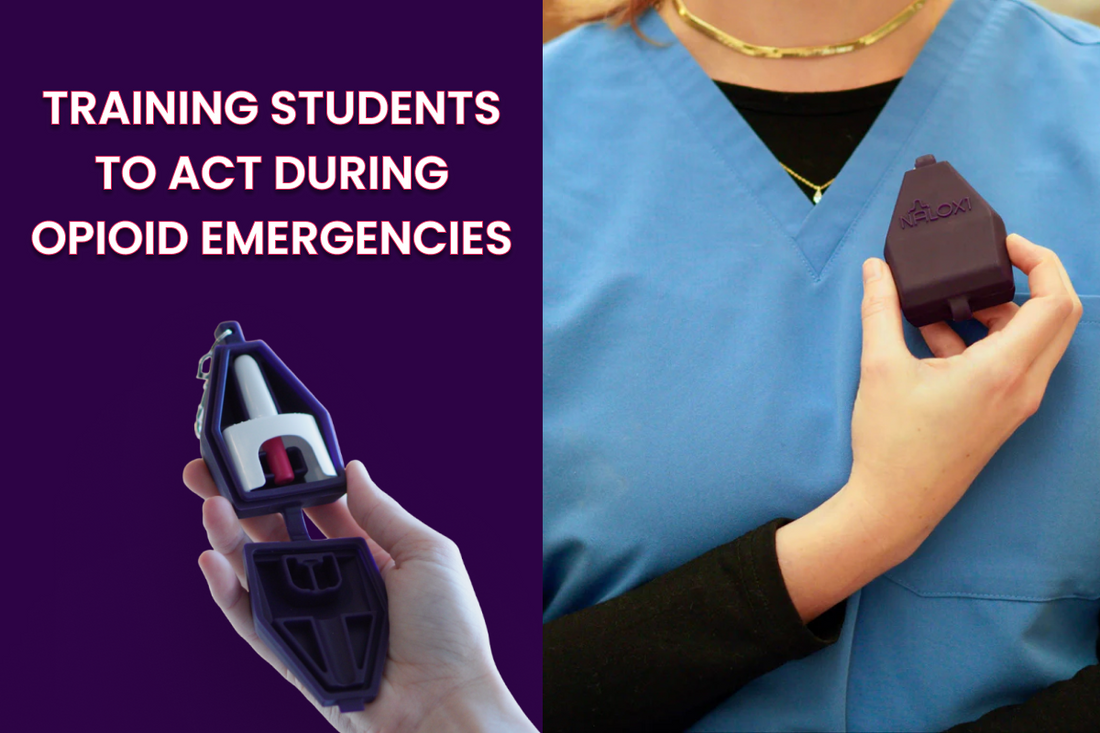
Training Students to Act During Opioid Emergencies
Share
The opioid crisis touches so many lives, leaving communities reeling and families searching for answers. While we rightly focus on preventing this heartache and offering paths to recovery, there's a vital piece of the puzzle often overlooked: what to do when an overdose happens right in front of us. Imagine if our students, the next generation, knew exactly how to act in such a moment. Equipping them with the skills to respond to an opioid emergency isn't just a good idea – it's a powerful way to save lives.
This blog post dives into why bringing opioid emergency training into our schools and universities is becoming such a crucial conversation, and how it can make a real difference.
The Hard Truths: What the Data Reveals
The truth is, the opioid crisis doesn't discriminate. It reaches into every corner of our communities, touching lives from all walks of life, and tragically, it's impacting our young people in ways we often don't expect. These aren't just numbers; they're stark realities that highlight just how critical it is to act:
-
Rising Overdose Deaths: Every single life lost to an opioid overdose is a tragedy, a family forever changed. Globally, the numbers are devastating. In 2019 alone, a staggering 125,000 people died from opioid overdose worldwide, and incredibly, nearly 80% of all drug-related deaths were linked to opioids. Think about that – almost every other drug-related death was due to this crisis. (Source: World Health Organization - WHO)
-
Youth Vulnerability: And it's not just intentional use. Our children are incredibly vulnerable to accidental overdoses, often simply by finding and taking medication not prescribed for them. A parent's worst nightmare, unfolding unexpectedly. (Source: SAMHSA)
-
College Campuses and Opioid Misuse: Even our college campuses, places of learning and growth, aren't immune. Opioid misuse among students is a quiet but serious concern. One study revealed that approximately 12% of college students had reported nonmedical use of prescription opioid pain relievers at some point in their lives. That's more than one in ten young adults grappling with this challenge. (Source: PMC, National Institutes of Health)
-
Accidental Overdoses are Common: Perhaps one of the most heartbreaking facts is that the vast majority of opioid overdose deaths – a shocking 94% – happen by accident. This isn't always about intentional self-harm; it's often a tragic mistake with fatal consequences. (Source: The ACT Foundation, citing Canadian Centre on Substance Use and Addiction statistics)
-
Fastest-Growing Population Needing Care: Looking at our neighbors, young people aged 15 to 24 in Canada are tragically the fastest-growing group needing hospital care due to opioid overdoses. This statistic serves as a stark warning, showing us who is increasingly at risk. (Source: The ACT Foundation, citing Canadian Centre on Substance Use and Addiction statistics)
These aren't just cold numbers; they reveal a stark truth: an opioid emergency can happen anywhere, even in a school hallway. But there's immense hope in this reality. By teaching our students how to respond, we're not just educating them – we're giving them the power to offer a second chance at life.
Why Focus on Student Training?
Beyond the immediate crisis, there are several compelling reasons to prioritize training students:
-
First Responders in Their Own Circles: Students are often the first to witness an overdose among their peers, friends, or even family members. Empowering them to act can provide critical immediate aid before professional medical help arrives.
-
Increased Naloxone Access: The availability of over-the-counter naloxone (e.g., Narcan, RiVive) has made it easier for individuals to carry this life-saving medication. To learn more about who should carry naloxone, you can find additional information.Training ensures that if naloxone is present, it can be administered correctly and effectively.
-
Reducing Stigma: Education and open dialogue around opioid emergencies can help break down the stigma associated with substance use disorder, encouraging individuals to seek help and fostering a more supportive environment.
-
Building a Healthier Community: By training students, we create a ripple effect. They become advocates, educators, and potential lifesavers within their communities, contributing to a broader public health response.
-
Promoting General First Aid Skills: Opioid overdose response training often includes essential first aid principles, such as calling 911 and basic life support (CPR), enhancing overall emergency preparedness.
What Does Effective Training Involve?
Effective training for students on opioid emergencies should cover:
-
Opioid Overdose Recognition: Teaching students to identify the signs and symptoms of an opioid overdose, such as pinpoint pupils, unconsciousness, and difficulty breathing.
-
Naloxone Administration: Practical instruction on how to correctly administer naloxone nasal spray. For more details on effective use and potential pitfalls, you can read about common mistakes to avoid when administering naloxone. This is a crucial skill, as naloxone can temporarily reverse the effects of an opioid overdose.
-
Calling for Help: Emphasizing the immediate need to call 911 and provide accurate information to emergency services.
-
Good Samaritan Laws: Informing students about Good Samaritan laws that protect individuals who seek medical assistance for someone experiencing an overdose.
-
Harm Reduction Principles: Introducing basic harm reduction strategies and connecting students to resources for prevention and treatment.
Resources for Training and Support:
Several organizations offer valuable resources for opioid overdose prevention and response training:
-
SAMHSA (Substance Abuse and Mental Health Services Administration): Offers an "Overdose Prevention and Response Toolkit" with comprehensive information and guidance. (Source: SAMHSA)
-
American Red Cross: Provides an online "First Aid for Opioid Overdoses Online Course" that teaches individuals to recognize signs, provide care, and administer naloxone. (Source: American Red Cross)
-
The ACT Foundation: Offers an "Opioid Overdose Response Training" module specifically designed to enhance high school CPR and AED programs. (Source: The ACT Foundation)
-
University Health Services: Many universities, like Columbia Health and Cornell Health, have developed their own opioid overdose prevention programs that include naloxone training and distribution for students, faculty, and staff.
The Path Forward
Training students to act during opioid emergencies is a proactive and empathetic approach to a complex public health challenge. By equipping them with vital knowledge and skills, we are not only preparing them to potentially save lives but also fostering a generation that is more aware, compassionate, and resilient in the face of the opioid crisis.
Let's work together to ensure that every student has the opportunity to become a confident and capable first responder in an opioid emergency.
nCase Tech is committed to exploring and supporting innovative solutions that empower communities. Stay tuned for more insights on how technology and education can enhance public health and safety.


